The decision between internal and external software development models has significant implications that require careful consideration. By examining the advantages and disadvantages of insourcing versus outsourcing, organisations can develop optimised development strategies.
Insourcing enables enhanced supervision, customisation, and seamless collaboration with in-house developers. However, supporting internal teams requires substantial investments in compensation, infrastructure, and training.
On the other hand, outsourcing provides access to specialised global talent pools and allows for flexible scaling of third-party resources. However, communication barriers can lead to delays, and concerns about intellectual property protection may arise.
To determine the ideal balance between insourcing and outsourcing for specific programs, it is crucial to assess factors such as time horizons, budgets, required capabilities, and quality needs. Tight deadlines may call for utilising internal developers, while niche skills might necessitate partnering with outsourced providers.
By carefully considering the increased accountability of insourcing compared to the flexibility and risks of outsourcing, organisations can make informed decisions that align with their specific goals and requirements.
Analysing the Pros and Cons of Insourced Software Development
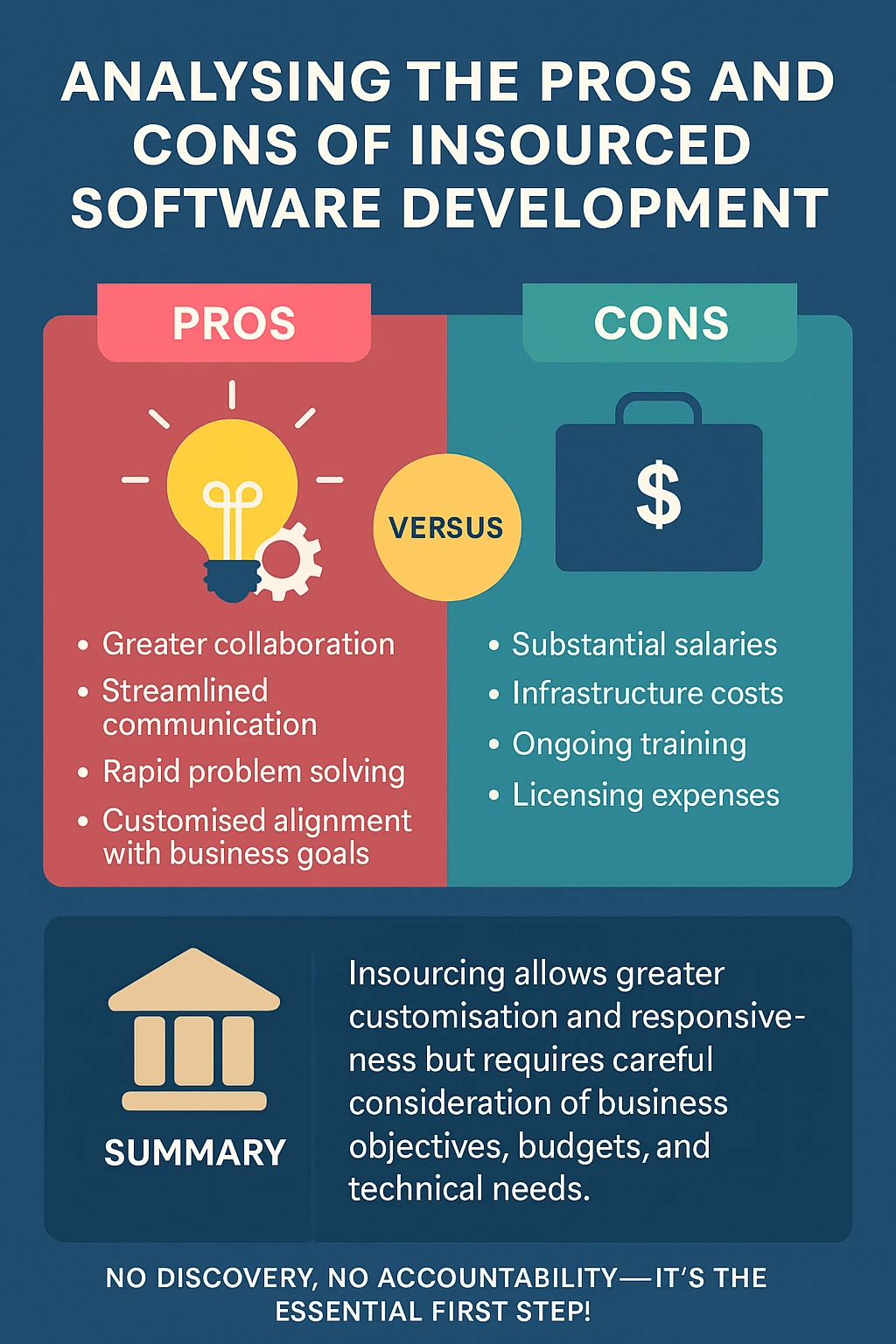
Insourcing software development offers notable advantages like enhanced collaboration, communication, and control. In-house teams enable seamless sharing of ideas, rapid issue resolution, and customised alignment with business goals. However, insourcing also comes with substantial costs for salaries, infrastructure, training, and licensing.
The on-site accessibility of internal developers provides tighter oversight of quality standards and development processes. But hiring and retaining specialised talent strains budgets. Close coordination between departments improves cohesion, but overhead expenses add up.
In summary, insourcing facilitates greater customisation and responsiveness through closer collaboration with in-house developers. But organisations must balance these benefits with the significant investment required for establishing and supporting an internal team. Carefully weighing factors like business objectives, budgets, and technical needs is crucial for determining if insourcing software development is the optimal choice.
Outsourced software development: Pros and cons
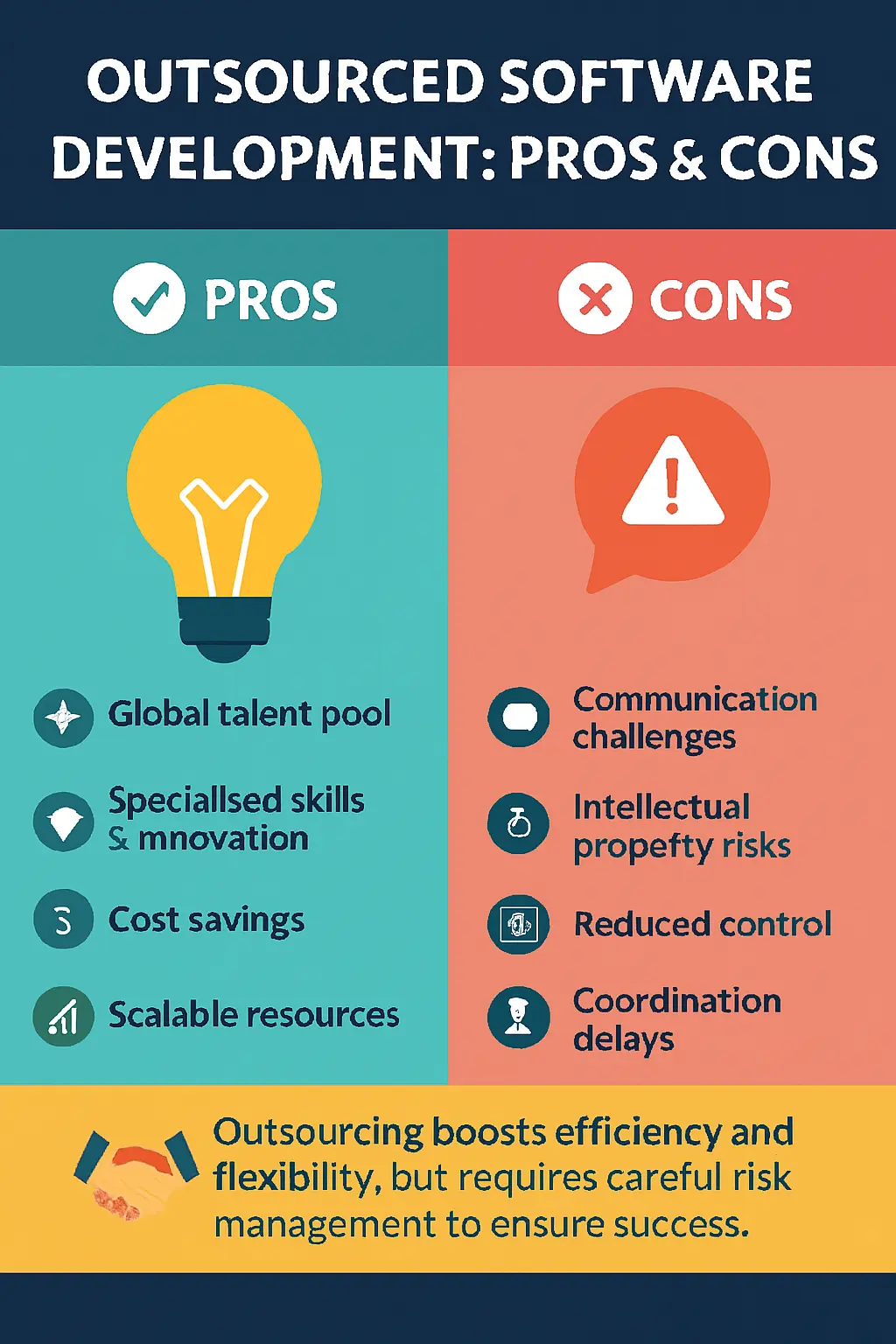
When it comes to software development services, businesses have the option to either insource or outsource. Outsourced software development has both advantages and disadvantages that organisations should consider. On the positive side, outsourcing provides access to a global talent pool, allowing companies to tap into specialised skills and knowledge that may not be available in-house. This can lead to increased efficiency and innovation, as well as cost savings. Additionally, outsourcing software development can provide flexibility in scaling resources up or down based on project demands, ensuring businesses have the necessary expertise at any given time. However, there are also potential downsides to outsourcing. Communication and coordination can become more challenging when working with remote teams, leading to delays and misunderstandings. Intellectual property protection may be a concern, as sharing sensitive information with external partners carries certain risks. Furthermore, outsourcing can sometimes result in a loss of control over the development process, making it harder to address issues or make changes quickly. Therefore, when deciding whether to outsource software development, businesses need to carefully weigh these pros and cons to determine the best approach for their specific needs.
Factors to consider when deciding between insourced and outsourced software development.
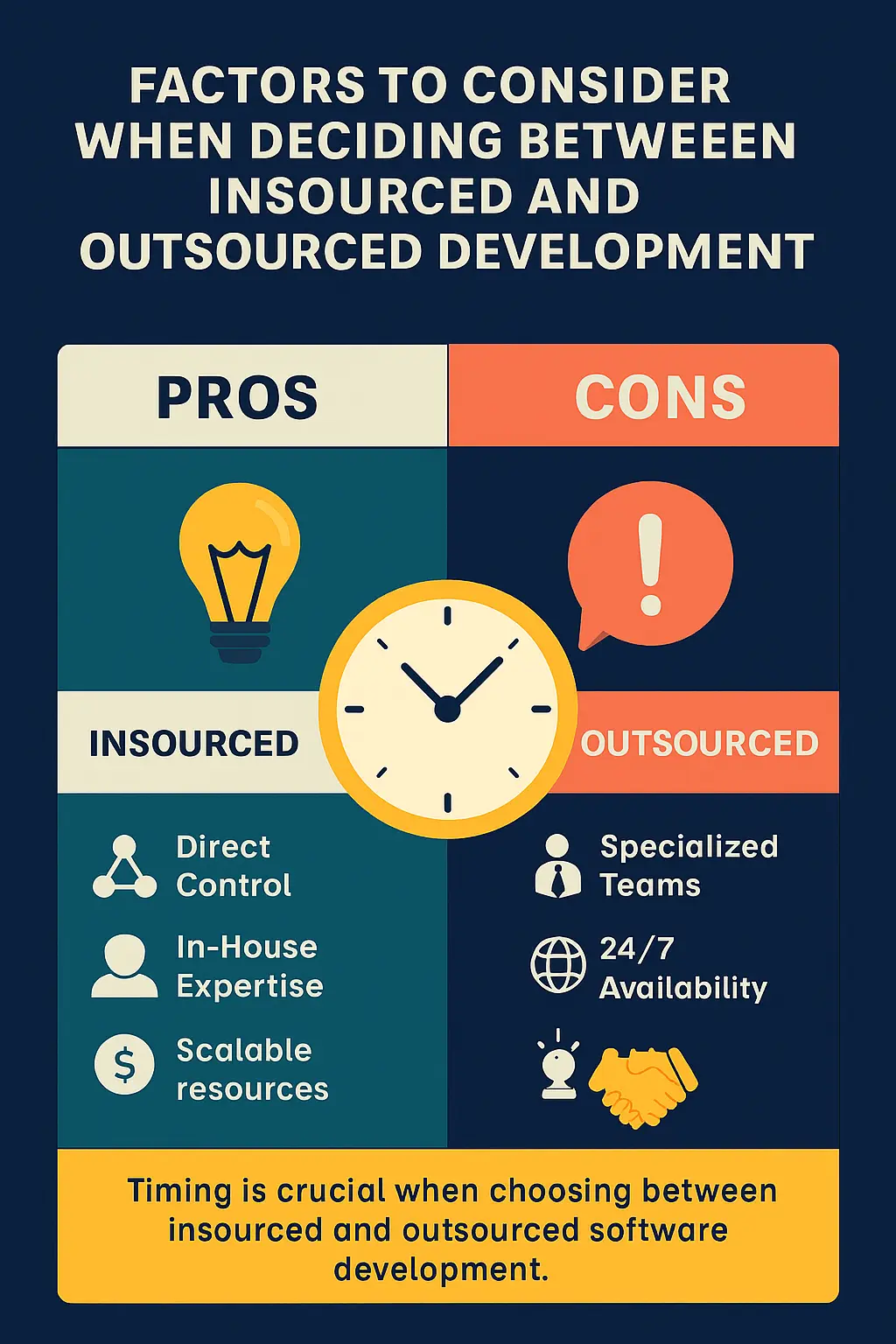
When it comes to deciding between insourced and outsourced software development, several factors need to be considered. One crucial aspect is the availability of time. Insourcing software development allows for greater control over project timelines. In-house teams have the advantage of immediate collaboration and communication, leading to quicker decision-making and problem-solving. With the ability to work in close proximity, developers can address issues promptly, ensuring efficient completion of tasks. On the other hand, outsourcing software development can save time by leveraging the expertise of specialised teams. By entrusting the project to external professionals, businesses free up their own resources, enabling them to focus on core competencies. Outsourcing also offers round-the-clock development services through global teams, facilitating 24/7 progress, even across time zones. The ability to allocate tasks to teams in different locations also allows for faster completion, as development can occur concurrently. Whether time is a critical factor or flexibility is required, weighing the advantages of insourcing and outsourcing will help determine the best approach for a successful software development project.
Cost comparison: Insourced vs outsourced software development
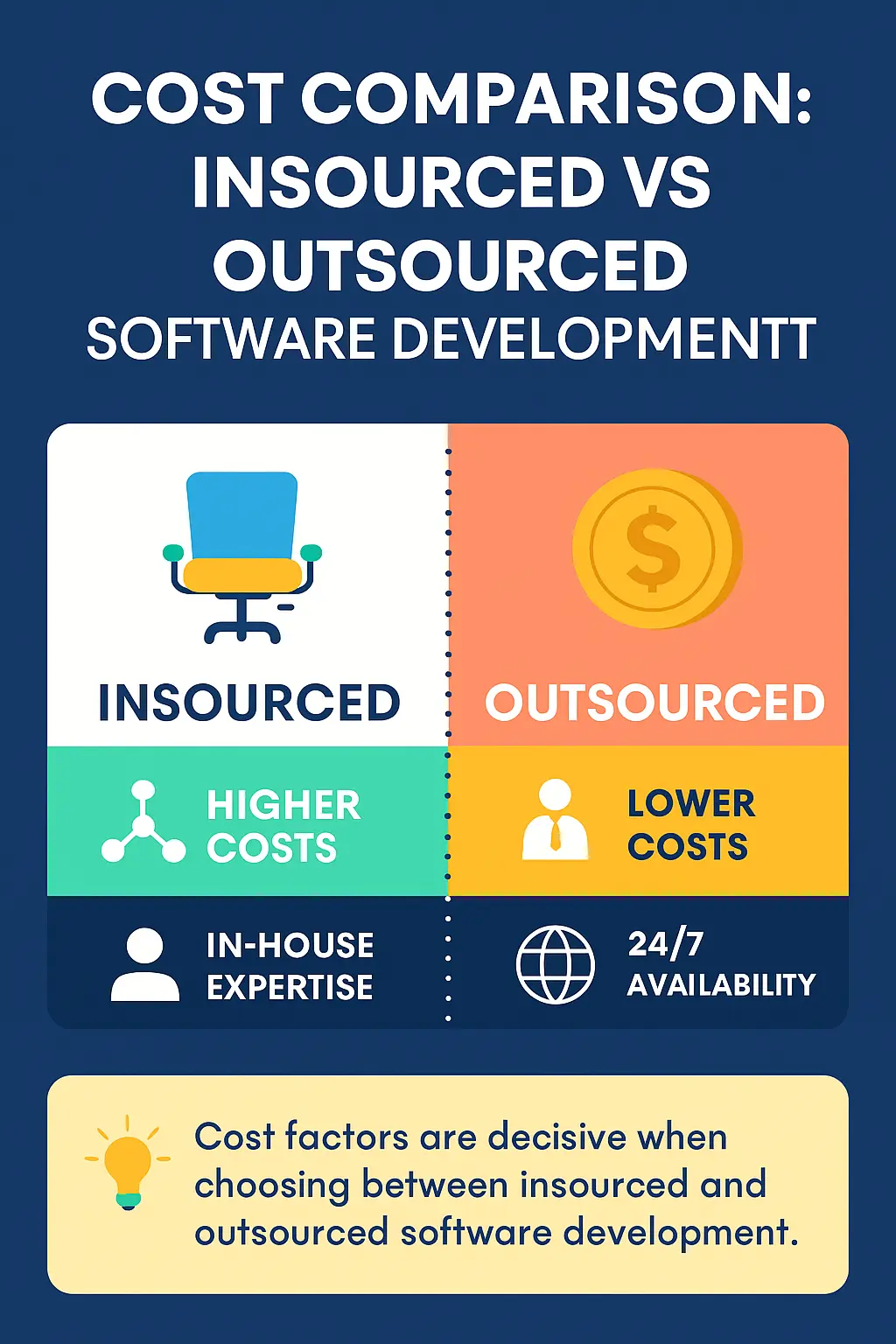
When it comes to software development, one crucial aspect that project managers and company executives must consider is the cost comparison between insourced and outsourced services. This analysis is a decisive factor in determining the most suitable approach for a project or company. Insourcing, or having an in-house team of developers, often entails higher costs, such as salaries, benefits, and infrastructure expenses. However, it offers several advantages, including better control over the development process, quick response times, and easier communication among team members. On the other hand, outsourcing software development to external firms can significantly reduce costs as companies are not responsible for the overhead associated with maintaining an internal team. This approach can provide access to a larger talent pool and specialised expertise, enabling companies to tackle complex projects efficiently. However, it can also introduce challenges such as cultural and linguistic differences, time zone discrepancies, and potential communication issues. Weighing the cost factors and considering the specific needs and goals of a project or company is crucial in making an informed decision between insourcing and outsourcing software development services. Ultimately, the choice depends on striking the right balance between cost-efficiency and the desired outcome, ensuring the successful completion of projects within the set budget.
Quality control: Ensuring the desired outcome in insourced software development
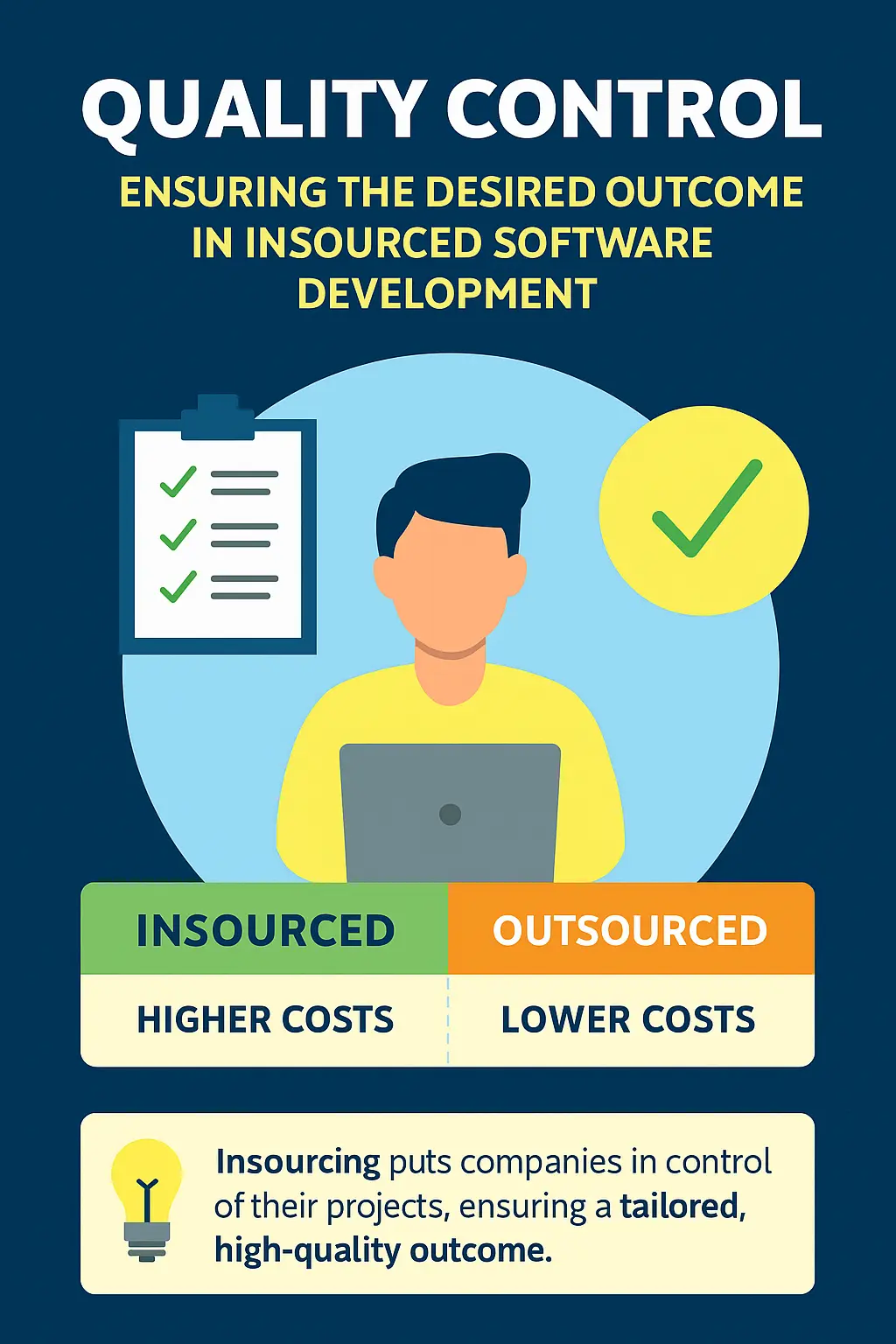
When it comes to insourced software development, one crucial aspect that companies must prioritise is quality control. Ensuring the desired outcome is essential for any company choosing to develop their software in-house. By keeping the development process within the company’s walls, businesses can maintain full control over the quality standards and have a direct hand in the creation of their software. This level of control allows companies to tailor the development process to their specific needs, resulting in a product that aligns perfectly with their vision and objectives. Additionally, having the development team in-house enables real-time collaboration, ensuring effective communication and seamless coordination between different departments. With the software development process happening in-house, companies can closely monitor every stage, promptly identify and address any potential issues, and implement necessary changes. In the end, insourcing software development empowers companies to take charge of their project, guaranteeing a high-quality outcome that is tailored to their unique requirements. So if you’re looking to develop software, don’t hesitate to consider keeping it in-house – it’s an investment that can pay off greatly in terms of quality and control.
Communication and collaboration challenges in outsourced software development

When it comes to outsourced software development, communication and collaboration are vital to the project’s quality and ultimate success. Challenges arising from language barriers, time zones, and cultural differences can significantly impact the project’s outcome. It is crucial for both parties to establish clear lines of communication from the outset, utilising tools such as video conferencing, instant messaging, and project management software. Regular check-ins, progress updates, and scheduled meetings can help bridge the gap and maintain a consistent flow of information. Moreover, adopting a proactive and collaborative approach, where both sides actively participate in discussions and problem-solving, can overcome communication challenges and enhance the overall quality of the project. By fostering open dialogue, encouraging feedback, and addressing concerns promptly, the outsourced team can align their work with the client’s expectations, resulting in a successful outcome.
In summary, when it comes to software development, both insourcing and outsourcing have their own benefits and drawbacks. Insourced software development offers greater control over the development process and promotes collaboration among team members. It also allows for better quality control, ensuring the desired outcome. On the other hand, outsourced software development can be more cost-effective and provide access to specialized skills and expertise. However, it may pose challenges in terms of communication and collaboration. Ultimately, the decision between insourcing and outsourcing should be based on factors such as cost, project requirements, and available resources.
To discuss how C9 can assist with modernising your outdated business software, contact us today. Our team of experts is here to help your company embrace the future.
Follow C9 on Facebook, Twitter, LinkedIn, YouTube, and view our location on Google Maps. Connect with our CEO Marcus Eddy on LinkedIn.
Software Development Wisdom Centre
Explore our extensive collection of articles unveiling contemporary development practises, industry breakthroughs, and specialised techniques. From efficient coding strategies to innovative architectural designs, our expert insights will help you master your development craft and enhance your technical capabilities.
Building a Humane Economy for Animals & Wildlife: The Role of Software and Technology
Top 15 Desktop Software Development FAQs Answered by C9
Custom Bespoke Software Development for Agriculture & Farming in Australia
Building a Future-Proof Business with Scalable Bespoke Software Development
5 Ways Bespoke Software Can Solve Your Inventory Management Headaches
System and App Integration FAQs Answered by C9 Software
Software Development FAQ answered by C9
The ROI of Custom Software Development: A Guide for Australian Businesses
Beyond the Build: Tips & Tricks to Maximise Efficiency with Custom Software (Australian Businesses)
Scaling with Confidence: Future-Proof Your Business with Scalable Software
AI-Powered Bespoke Software: Building the Future, One App at a Time
Reduce Operational Costs with Custom Logistics Software
5 Ways Custom Software Can Improve Your Retail Business
Avoiding Skill Stagnation with Outsourced Software Partners
The True Hourly Cost of Inhouse vs Outsourced Software Development Team
What are the Benefits and Drawbacks of Inhouse and Outsourcing Software Development Project Management & Administration?
What You Need to Know About Insourced vs Outsourced Software Development Services
Understand the Advantages and Disadvantages of Internal vs. External Software Development for Business Analysis
Modernise Antiquated Business Software Before It's Too Late
Custom Software Development: The Secret Weapon to Boost Your Business's Success
Top 15 Low Code / No Code Development FAQ's Answered by C9
Empower Your Team: Citizen Developers and the Rise of Low-Code/No-Code in Australia